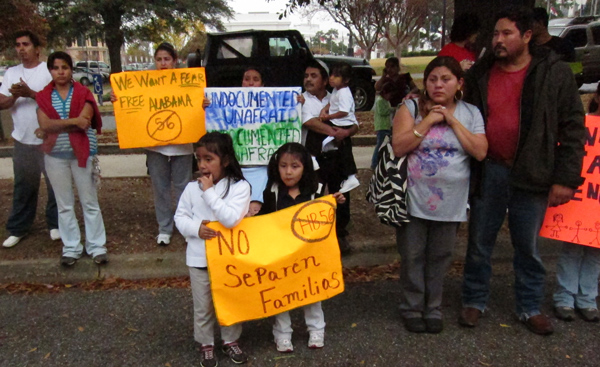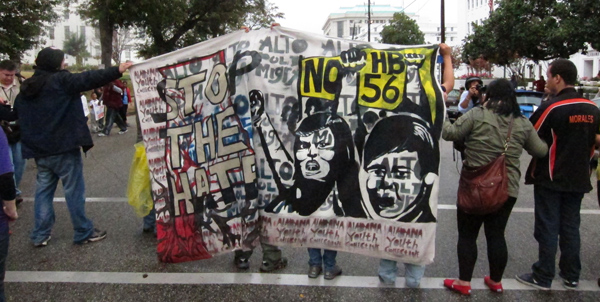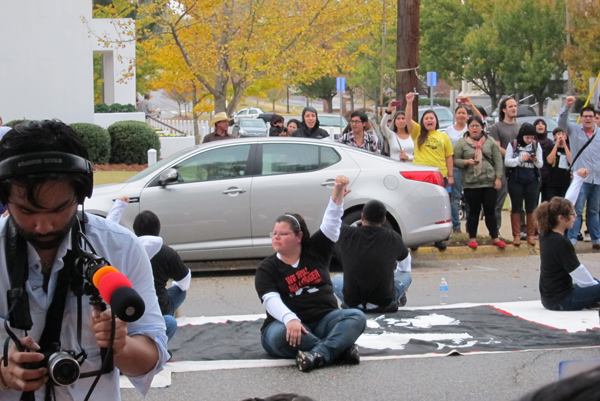For more than 20 years, Teaching Tolerance, based in Montgomery, Ala., has worked to help educators embrace the diverse classroom. We strive toward bias-free schools. We advocate acceptance, respect, equality and safety for all students.
Our state is also the locale for the harshest anti-immigrant law in the country—HB 56, which had required schools to account for the immigration status of its new students and their parents. The law has sent widespread fear into the Latino community. Parents kept children home from school. Some teachers targeted students and asked about their legal status. Immigrant students have been the target of bullying.
So when a group of protesters from Philadelphia to California came to Montgomery Tuesday to speak out against the law and ask for its repeal, we had to be there.
 Among the supporters of Tuesday’s protest of HB 56, were these children. “Don’t separate families,” their sign reads.
Among the supporters of Tuesday’s protest of HB 56, were these children. “Don’t separate families,” their sign reads.“When immigrant rights are under attack, what do we do? Stand up, fight back,” the crowd of about 75 people chanted in a call and response. The protesters walked the four blocks surrounding Alabama’s State Capitol. Their destination was the State House across the street from the Capitol building. They hoped to hand-deliver a letter to one of the law’s outspoken sponsors, Sen. Scott Beason, before sitting a few hundred feet away on the street between the Capitol and the State House in a gentle, steady rain.
The crowd included mothers pushing baby strollers, men, women, children and students. People stood in support of a core of 13 undocumented students and parents, who later sat in the street, blocked traffic and told stories of how anti-immigrant laws affected them. The crowd began to swell as area students joined the group, then law enforcement officers, the media and passersby.
The protest was powerful and raw.
Knowing that these people were willing to risk their freedom and potentially deportation to put a human face on the immigration issue, was tremendously emotional.
Catalina Rios from Detroit, stood to take her turn at the bullhorn. She has been “living every day not sure if my parents will come home from work.”
 Protesters link arms across Union Street.
Protesters link arms across Union Street.Diane Martel, an Alabama high school student, gave a teary account of her friends being limited by anti-immigrant laws. “We all have the same dreams,” she said.
“An attack on the undocumented is an attack on us all,” said Cesar Marroquin 21, a Pennsylvania resident and undocumented student brought to the United States from Lima, Peru, as a child.
The core students wore black T-shirts that read, “Undocumented. Unafraid. We will no longer remain in the shadows,” in bold red letters. They were ready to be arrested. All of them were. The charge: disorderly conduct.
“We want to create a different reality,” said Mohammad Abdollahi, who helped organize the protest “As a community, we have a voice. We speak for the undocumented everywhere.”
Abdollahi was part of a group called Dream Activist, a student-led group based in Ann Arbor, Mich. working toward passage of the federal DREAM Act and immigration reform.
For their part, law enforcement blocked off the street and stood by to assess the situation, before moving in to make arrests after about two hours.
 “Undocumented, unafraid!”
“Undocumented, unafraid!”
While HB 56 is aimed at Latinos, Inas Bedwan a Palestinian, came to support the protest. She had heard the stories of immigrants being stopped because “they don’t look like they are from here.” The Montgomery resident and mother of four also has heard of elementary school students being questioned about their immigration status and that of their parents. Bedwan brought three of her sons to protest with her.
“It’s just not right,” she said, her hijab protecting her hair from the rain. “Something must change. We support that change.”
Her oldest son Muamer, 16, concurred, saying, “It’s an unjust law.”
And then there was a family of seven including three school-age children, a pre-schooler and 7-month-old baby—all citizens of the United States. Their parents, however, are undocumented. They were advised not to give their names. But the mom felt the protest was important enough to take her children out of school early.
The children were painfully aware of the impact of the law.
“We don’t want them to fire my mom and take us to a different place,” said the 6-year-old. “We want to stay here.”
Williamson is associate editor at Teaching Tolerance.